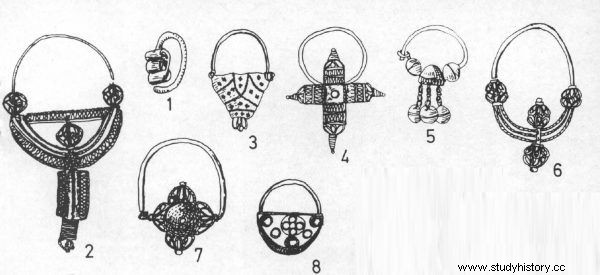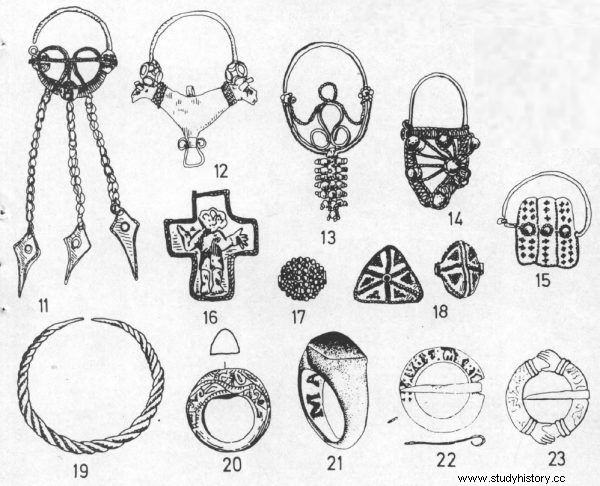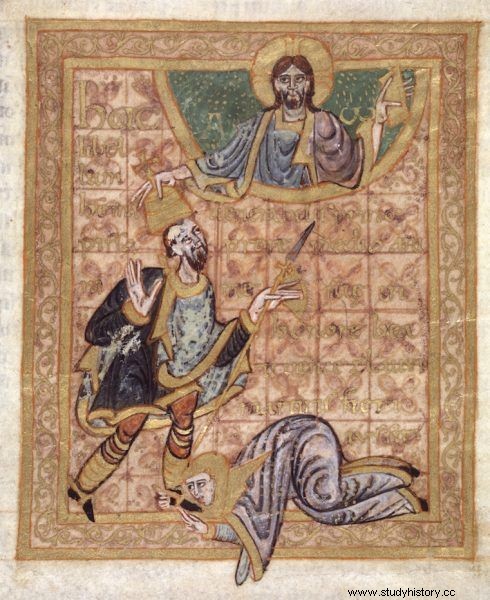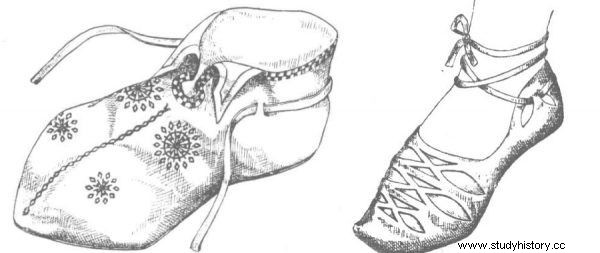We do not know the portraits of Princess Dobrawa. Her rings and dresses have not survived. We know, however, that she had to be an extremely elegant lady. And that like no other woman in Poland - she loved gold.
What did Wielkopolska's jewelry look like in the 10th century? Contrary to appearances, it was at a really high level.
These weren't vulgar chains or ascetic, patternless rings. From the time of the wife of Mieszko I Dobrawa, for example, extremely intricately made earrings with an elegant, ingenious finish are known. On one of them hangs a wide openwork pendant; from another, a triangular bead with an intricate pattern. There are also decorations of an eminently Christian character - such as an earring in the shape of an isosceles cross.

Selected designs of early medieval jewelry. Redraws from the work of H. Kóčka-Krenz, "Medieval jewelry in Poland as a chronological marker", 1997.
Piast jewelery from this era shows clear inspiration from the art of southern Europe or even the Byzantine Empire. According to archaeologists, even more decisive conclusions can be made. Some of the forms of ornaments came to Wielkopolska only with Dobrawa, and it was she who made them popular among the local elite, they began to be copied and improved. After all, every great lady - the wife of a prince's brother, commander of the army or commander of the city - dreamed of looking as noble as the ruler herself.
Perhaps Dobrawa's love of jewelery also hides the solution to the mystery of a peculiar building that was located right next to Mieszko's palace in Poznań. There was a prince's goldsmith's workshop in a wooden hut. Archaeologists found fragments of casting crucibles with frozen drops of precious metal, as well as garnet eyes, pieces of gilded wood and glass beads.

Selected designs of early medieval jewelry. Redraws from the work of H. Kóčka-Krenz, "Medieval jewelry in Poland as a chronological marker", 1997.
The very existence of a similar plant is surprising. The Piasts, thanks to the slave trade, even slept on the mountains of Arab silver. However, gold was a rare and expensive material in their country. If specialists in this metal worked under the ruler's eye, and their workshop was built almost wall-to-wall with the prince's palace, then someone from the ruling family had to be behind the initiative. It could have been Dobrawa. In turn, an extraordinary studio can prove not only her love, but also a real passion for luxurious decorations.
However, a beautiful brooch, earring or earring looked appropriate only against the background of a stylish outfit. Dobrawa must have attached great importance to the wardrobe. After all, she was the eyes of the entire court. She imported her clothes, at least in part, from abroad, from the best tailoring workshops in the Reich. Fashion in the 10th century changed slowly, so she probably wore the same clothes as the greatest Czech ladies. On the other hand, much is known about the costumes of the latter thanks to the influential Princess Emma, who lived exactly in those years.
The wife of Bolesław II Przemyślida and the sister-in-law of Dobrawa was an almost unique case for the early Middle Ages:a woman we know what she looked like. On the title page of the codex from Wolfenbüttel - a richly decorated and illuminated book that she commissioned herself - there is a miniature of Emma groveling in front of Saint Wenceslas. If Dobrawa took the same style lessons, she wore long, flowing robes that reached to the feet and covered the whole body except the hands.
Her outer dresses, with gold or purple trim, were made of expensive, probably foreign materials. Only the common people flaunted linen clothes - the duchess had to equip herself with fabrics that the Slavic world had not seen. Silks, morocco, goldheads. They were made of the familiar, but of course properly selected linen, only worn next to the body and acting as the princess' underwear.

Princess Emma on the title page of the codex from Wolfenbüttel.
The chastity of the garment was ensured by narrow sleeves and tightly fitted cuffs. They were sewn in such a way as to eliminate the risk of exposing any indecent part of the body. Including the wrist. This element of the Slavic costume was mentioned by the Jewish traveler Ibrahim ibn Jakub, but tight sleeves can also be seen in the portrait of Emma.
The duchess also covered her legs. For this, she probably used crochet stockings, although it is not certain whether they were produced in Greater Poland as early as the 10th century. If not, Dobrawa could always send some slaves to the market in Prague and exchange them for decent German stockings.
The Duchess's shoes were works of art. The leather shoes of great ladies were decorated with embroidery, placed on the vamp covering the foot, and often also on the uppers. An additional ornament could be studs, known from shoes worn by the elite in Ruthenia.

Women's shoes from Gdańsk (11th-12th century) and Opole (11th century).
It all looked beautiful and Dobrawa could not count on special comfort only. Only in the next century, shoes with a shape matching the foot profile will appear in Poland. In the time of Mieszko's wife, the right and left shoes looked identical and could be used alternately. Though not necessarily to the best effect.
The creation was completed with a scarf. It was an obligatory item of clothing for every married woman. As a rule, it was white - hence the word "white-headed" for old women. The duchess, however, could not afford mediocrity. Emma has a golden scarf in her portrait. Dobrawa probably also assumed a similar one. Especially since they would match perfectly with her pure gold jewelry.
Bibliography:
- Chmielewski W., Footwear [in:] Dictionary of Slavic antiquities , vol. 3, ed. W. Kawalenko, G. Labuda, Z. Stiebier, Wrocław 1968.
- Dekówna M., Goldsmithing [in:] Dictionary of Slavic antiquities , vol. 7, ed. G. Labuda, Z. Stieber, Wrocław 1982.
- Kamińska J., Clothing [in:] Dictionary of Slavic antiquities , vol. 3, ed. W. Kawalenko, G. Labuda, Z. Stiebier, Wrocław 1968.
- Kóčka-Krenz H., Medieval jewelry in Poland as a chronological marker , "Archaelogia Historica Polona", vol. 6 (1997).
- Kóčka-Krenz H., Northwest Slavic jewelry in the early Middle Ages , Poznań 1993.
- Kóčka-Krenz H., Residence of the first Piast rulers in the city of Poznań , "Nauka", No. 2 (2005), p. 88; taż, The Oldest Poznań [in:] Civitas Posnaniensis. Studies in the history of medieval Poznań , eds. Z. Kurnatowska and T. Jurek, Poznań 2005.
- Kóčka-Krenz H., West Slavic round pendants [in:] Instantia est Mater Doctrinae. Jubilee book of prof. dr. hab. Władysław Filipowiak , r E. Wilgocki, Szczecin 2001.
- Majbroda K., On the naming of women through the ages in the anthropological and cultural context , "Kultura Ludowa", No. 1 (2005).
- Ibrāhīm Ibn Jakūba's account of his travels to Slavic countries in al-Bekrī's story , transl. and comp. T. Kowalski [in:] Monumenta Poloniae Historica , vol. 1, Krakow 1946.
- Rosen-Przeworska J., Dress in Poland in the early Middle Ages , "Polish Folk Art", vol. 8 (1954).
- Samsonowiczowa A., Studies on clothing of the population living in Poland in the early Middle Ages , "Works and Materials of the Archaeological and Ethnographic Museum in Łódź. Archaeological Series ”, No. 24 (1974).
- Sobiesiak J.A., Bolesław II Przemyślida ( † 999) , Krakow 2006.
- Trawkowski S., Clothing and body care [in:] The culture of medieval Poland, 10th – 13th centuries , ed. J. Dowiat, Warsaw 1985.
- Wiklak H., Polish early medieval shoes from the 8th-13th centuries based on excavations , "Early Medieval Materials", vol. 6 (1969).
